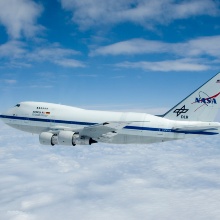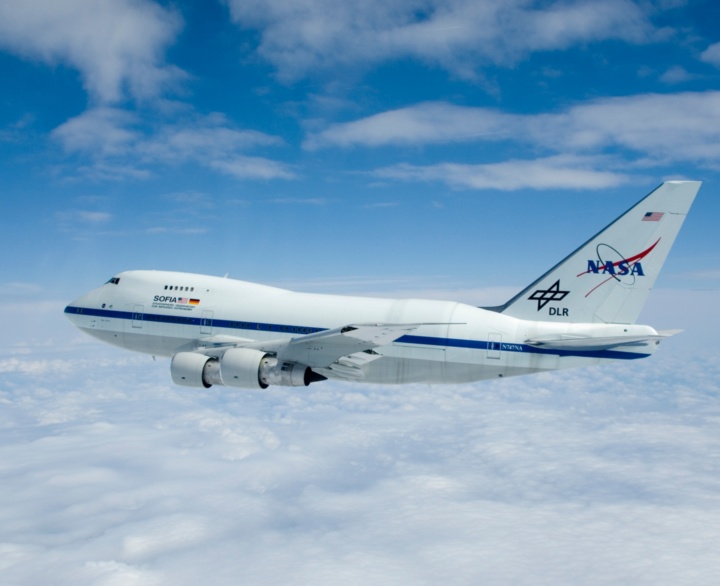Lovers of astronomy will have an opportunity to visit the flying infrared observatory SOFIA at Stuttgart Airport from September 15-20. The aircraft is the only flying infrared observatory in the world, and is one of the largest bilateral US-German projects in the field of space exploration. It is one of the largest externally-funded projects at the University of Stuttgart, who coordinates SOFIA’s scientific operations in Germany. SOFIA will carry out its first observation flight over Europe on September 18-19.
Update, September 15, 2019:
SOFIA is delayed. It will be landing at Stuttgart Airport on Monday, September 16, 2019, at 4:14 am.
The Stratospheric Observatory for Infrared Astronomy (SOFIA) is a refitted Boeing 747 SP with a 17-tonne telescope on board. Scientists often travel on board the aircraft, for example to observe young stars and planetary systems being formed or to study the Milky Way. SOFIA is coming to Stuttgart on September 15, 2019. It will be landing at Stuttgart Airport in the early hours of the morning, and flies back to its home base in California on Friday, September 20.
Successful cooperation between the University of Stuttgart, DLR and NASA
The Baden-Württemberg Minister for Science, Research and the Arts Theresia Bauer says “SOFIA serves as a symbol for the international and long-lasting successful cooperation between the University of Stuttgart, the German Aerospace Center (DLR) and the National Aeronautics and Space Administration (NASA) in the field of space exploration. This underlines the importance of Baden-Württemberg as one of the leading partners in Europe when it comes to aerospace engineering.”
Guided tours of SOFIA
In Stuttgart, those who are interested can see SOFIA for themselves from the airport’s visitor terrace, which is free of charge to enter. What’s more, they can also sign up for a guided tour of the observatory. There are a limited number of places available. Registration must be done online. Because the aircraft will be based on the apron of the airport, those wanting to go on the tour must go through the same security checks as when checking in for a flight. One person can register up to five people at once – providing he or she gives their full names and dates of birth.
Tours available on September 16, 17 and 19:
Length: roughly two hours
Online registration: possible in two stages from Thursday, September 5 at 7.00 am and 7.00 pm at: http://bit.ly/2MP9Upb
Planetarium show and exhibition
In a mobile planetarium in fulldome format, viewers can experience a SOFIA flight up close, including the preparations. Entrance is free.
Show-times:
Monday, September 16: 10.00 am, 11.30 am, 4.00 pm and 6.00 pm;
Tuesday, September 17: 10.00 am, 11.30 am, 4.00 pm and 6.00 pm;
Wednesday, September 18: 10:00 am, 11.30 am;
Thursday, September 19: 11.30 am, 4.00 pm and 6.00 pm
Length: 45 to 60 minutes
Location: Stuttgart Airport, between Terminals 0 and 1
Likewise, an exhibition with models, videos and informational material explains some of the special features of the observatory as well as the astronomical mission of the flying infrared observatory in a way which is suitable for the general public. On September 16, 17 and 19, schoolchildren from the network of schools that make up the German SOFIA Institute (DSI) at the University of Stuttgart will explain the special features of SOFIA and its mission, which includes infra-red experiments among other things.
Time: September 16-27, 2019
Location: Stuttgart Airport, terrace level in Terminal 3, next to the exit to the visitor terrace
Annual Conference of the German Astronomical Society
The reason for SOFIA’s visit to Stuttgart is the “Mission to the Universe – From Earth to Planets, Stars & Galaxies” conference held by the German Astronomical Society, which organizes the DSI at the University of Stuttgart. Roughly 250 researchers from around the world are meeting at the Vaihingen Campus at the University of Stuttgart from September 16-20. The German Astronomical Society is one of the oldest astronomical societies in Europe. It was founded in 1863.
More information on the conference.
Public lecture
An exciting part of the German Astronomical Society’s conference for the public is a lecture. Under the title of “A look into a hidden universe – highlights of the flying observatory SOFIA”, Dr. Harold Yorke, Director SOFIA Science Mission Operations reports on some of the important new scientific discoveries made by SOFIA and what they mean for our understanding of the cosmos. This is followed by a short presentation from the Japanese astrophysicist Dr. Yoko Okada from the University of Cologne about her experiences flying on board the plane. Flying on board the plane has enabled her to collect data for researching interstellar space in the Milky Way. The debate will be moderated by the German physicist and ESA astronaut Prof. Reinhold Ewald.
Time: September 19, 2019, 8 pm
Location: Hospitalhof, Büchsenstraße 33, 70174 Stuttgart
Further information
First scientific flight over Europe
SOFIA is combining its trip to Stuttgart with what will be a first. On September 18, the flying observatory SOFIA will take off from Stuttgart Airport shortly after sunset (around 7.40 pm) on its first scientific observation flight over Europe. During the mission, which is due to last about ten hours, the crew will carry out a number of astronomical observations. The American instrument HAWC+, which is currently mounted on the telescope, can measure cosmic magnetic fields in far infrared light. Scientists want to investigate the area around the supermassive black hole in the galaxy Markarian 231 in the constellation Ursa Major, to give just one example. They hope to gain new insights into the connection between the magnetic fields in the disc structure around the black hole and the radio jets – the highly focused and runaway gas accretions perpendicular to these discs, which among other things transmit intense radio emissions. This kind of observation is only possible with SOFIA, because no other observatory can measure magnetic fields in this wavelength range.
One advantage of flying over Europe is that SOFIA will be further north than its usual base in southern California. The nearer to the poles the infrared observatory flies, the less water vapor there is in the atmosphere around it – and the better the conditions are for making observations. The SOFIA team has obtained a special permit from the local authorities exempting it from the restrictions on night flights for the return at around 5.30 am on Thursday, which is shortly before Stuttgart Airport actually starts operations at 6 am.
Expert Contact:
University of Stuttgart contact persons
Dr. Dörte Mehlert, University of Stuttgart, German SOFIA Institute, Tel.: +49 711 685-
69632, E-Mail
Lydia Lehmann, University of Stuttgart, University Communications, Tel.: +49 711 685-82297, E-Mail
DLR contact persons
Clemens Plank, Space Administration, Strategy and Communications at the German Aerospace Center (DLR), Tel.: +49 228 447-394, E-Mail
Martin Fleischmann, Space Administration, Strategy and Communications at the German Aerospace Center (DLR), Tel.: +49 228 447-120, E-Mail
Stuttgart Airport contact person
Beate Schleicher, Stuttgart Airport, Corporate Communications, Tel.: +49 711 948-2100, E-Mail



